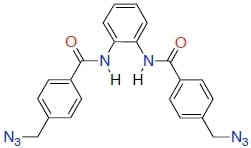N,N'-(1,2-Phenylene)-bis[4-(azidomethyl)benzamide]
Abstract
:Experimental Section
General
Safety Note
Synthesis of N,N'-(1,2-phenylene)-bis[4-(azidomethyl)benzamide] (2)
Supplementary materials
Supplementary File 1Supplementary File 2Supplementary File 3Supplementary File 4Acknowledgements
References and Notes
- Scriven, E.F.V.; Tumbull, K. Azides: Their preparation and synthetic uses. Chem. Rev. 1988, 88, 297–368. [Google Scholar] [CrossRef]
- Curtius, T. Ueber Stickstoffwasserstoffsäure (Azoimid) N3H. Ber. Dtsch. Chem. Ges. 1890, 23, 3023–3033. [Google Scholar] [CrossRef]
- Bräse, S.; Gil, C.; Knepper, K.; Zimmermann, V. Organic azides: An exploding diversity of a unique class of compounds. Angew. Chem. Int. Ed. 2005, 44, 5188–5240. [Google Scholar] [CrossRef] [PubMed]
- Chandrasekhar, S.; Prakash, S.Y.; Rao, C.L. Poly(ethylene glycol) (400) as superior solvent medium against ionic liquids for catalytic hydrogenations with PtO2. J. Org. Chem. 2006, 71, 2196–2199. [Google Scholar] [CrossRef] [PubMed]
- Rao, H.S.P.; Siva, P. Facile reduction of azides with sodium borohydride/copper(II) sulfate system. Synth. Commun. 1994, 24, 549–555. [Google Scholar]
- Kolb, H.C.; Sharpless, K.B. The growing impact of click chemistry on drug discovery. Drug Discov. Today 2003, 8, 1128–1137. [Google Scholar] [CrossRef]
- Agrawal, J.P.; Hodgson, R. Organic Chemistry of Explosives, 1st ed.; John Wiley & Sons, Inc.: Chichester, UK, 2006. [Google Scholar]
- Lin, T.S.; Prusoff, W.H. Synthesis and biological activity of several amino analogues of thymidine. J. Med. Chem. 1978, 21, 109–112. [Google Scholar] [CrossRef] [PubMed]
- Kohn, M.; Breinbauer, R. The Staudinger ligation- A gift to chemical biology. Angew. Chem. Int. Ed. 2004, 43, 3106–3116. [Google Scholar] [CrossRef] [PubMed]
- Kolb, H.C.; Finn, M.G.; Sharpless, K.B. Click chemistry: Diverse chemical function from a few good reactions. Angew. Chem. Int. Ed. 2001, 40, 2004–2021. [Google Scholar] [CrossRef]
- Binder, W.H.; Sachsenhofer, R. ‘Click’ chemistry in polymer and materials science. Macromol. Rapid Commun. 2007, 28, 15–54. [Google Scholar] [CrossRef]
- Díaz, D.D.; Punna, S.; Holzer, P.; McPherson, A.K.; Sharpless, K.B.; Fokin, V.V.; Finn, M.G. Click chemistry in materials synthesis. 1. Adhesive polymers from copper-catalyzed azide-alkyne cycloaddition. J. Polym. Sci. Polym. Chem. 2004, 42, 4392–4403. [Google Scholar] [CrossRef]
- Mazurkiewicz, R. Novel synthesis and rearrangement of 3,l,5-benzoxadiazepines. Monatsh. Chem. 1988, 119, 1279–1287. [Google Scholar] [CrossRef]
- Bachl, J.; Díaz, D.D. N,N'-1,2-Phenylenebis[4-(chloromethyl)benzamide]. Molbank 2010, 2010, M705. [Google Scholar] [CrossRef]
- See Supplementary Files.
- Armarego, W.L.F.; Perrin, D.D. Purification of Laboratory Chemicals, 4th ed.; Butterworth- Heinemann: Oxford, UK, 1996. [Google Scholar]

© 2010 by the authors; licensee MDPI, Basel, Switzerland. This article is an open access article distributed under the terms and conditions of the Creative Commons Attribution license (http://creativecommons.org/licenses/by/3.0/).
Share and Cite
Bachl, J.; Díaz, D.D. N,N'-(1,2-Phenylene)-bis[4-(azidomethyl)benzamide]. Molbank 2010, 2010, M707. https://doi.org/10.3390/M707
Bachl J, Díaz DD. N,N'-(1,2-Phenylene)-bis[4-(azidomethyl)benzamide]. Molbank. 2010; 2010(4):M707. https://doi.org/10.3390/M707
Chicago/Turabian StyleBachl, Jürgen, and David D. Díaz. 2010. "N,N'-(1,2-Phenylene)-bis[4-(azidomethyl)benzamide]" Molbank 2010, no. 4: M707. https://doi.org/10.3390/M707
APA StyleBachl, J., & Díaz, D. D. (2010). N,N'-(1,2-Phenylene)-bis[4-(azidomethyl)benzamide]. Molbank, 2010(4), M707. https://doi.org/10.3390/M707




